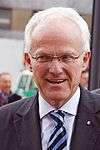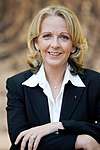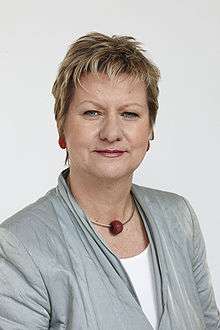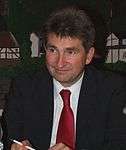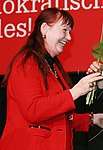2010 North Rhine-Westphalia state election
The 2010 Rhine-Westphalia state election was held on 9 May 2010 to elect the members of the Landtag of North Rhine-Westphalia. The incumbent coalition government of the Christian Democratic Union (CDU) and Free Democratic Party (FDP) led by Minister-President Jürgen Rüttgers was defeated. The Social Democratic Party (SPD) subsequently formed a minority government with The Greens, led by SPD leader Hannelore Kraft, who became Minister-President.
| ||||||||||||||||||||||||||||||||||||||||||||||||||||||||||||||||||||
All 181 seats in the Landtag of North Rhine-Westphalia 91 seats needed for a majority | ||||||||||||||||||||||||||||||||||||||||||||||||||||||||||||||||||||
|---|---|---|---|---|---|---|---|---|---|---|---|---|---|---|---|---|---|---|---|---|---|---|---|---|---|---|---|---|---|---|---|---|---|---|---|---|---|---|---|---|---|---|---|---|---|---|---|---|---|---|---|---|---|---|---|---|---|---|---|---|---|---|---|---|---|---|---|---|
| Turnout | 7,760,546 (59.3%) | |||||||||||||||||||||||||||||||||||||||||||||||||||||||||||||||||||
| ||||||||||||||||||||||||||||||||||||||||||||||||||||||||||||||||||||
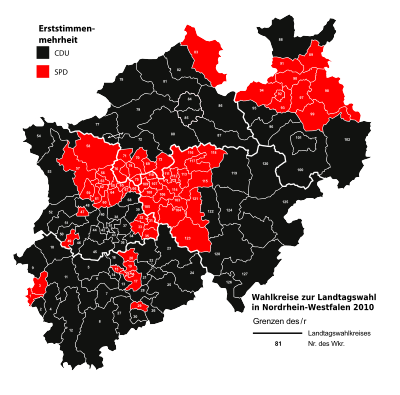 Results for the direct mandates. | ||||||||||||||||||||||||||||||||||||||||||||||||||||||||||||||||||||
| ||||||||||||||||||||||||||||||||||||||||||||||||||||||||||||||||||||
Campaign and issues
As the election was held in Germany's most populous state, it was seen as a test of the federal CDU–FDP government's performance after seven months in office. The government was accused of being indecisive as the two coalition partners had different aims.[1] As the Bundesrat is made up of representatives from the states, the federal government also risked losing its narrow Bundesrat majority in this election.[2]
Other factors in the election were the proposed EU bailout of Greece as well as a fundraising scandal in the governing party and debate over the state's education policy.[3]
Parties
The table below lists parties represented in the previous Landtag of North Rhine-Westphalia.
| Name | Ideology | Leader(s) | 2005 result | |||
|---|---|---|---|---|---|---|
| Votes (%) | Seats | |||||
| CDU | Christian Democratic Union of Germany Christlich Demokratische Union Deutschlands |
Christian democracy | Jürgen Rüttgers | 44.8% | 89 / 187 | |
| SPD | Social Democratic Party of Germany Sozialdemokratische Partei Deutschlands |
Social democracy | Hannelore Kraft | 37.1% | 74 / 187 | |
| Grüne | Alliance 90/The Greens Bündnis 90/Die Grünen |
Green politics | Sylvia Löhrmann | 6.2% | 12 / 187 | |
| FDP | Free Democratic Party Freie Demokratische Partei |
Classical liberalism | Andreas Pinkwart | 6.2% | 12 / 181 | |
Opinion polling
| Polling firm | Fieldwork date | Sample size |
CDU | SPD | Grüne | FDP | Linke | Others | Lead |
|---|---|---|---|---|---|---|---|---|---|
| 2010 state election | 9 May 2010 | – | 34.6 | 34.5 | 12.1 | 6.7 | 5.6 | 6.5 | 0.1 |
| YouGov | 30 Apr–6 May 2010 | 1,007 | 35 | 35.5 | 10.5 | 7 | 7 | 5 | 0.5 |
| Emnid | 28 Apr–5 May 2010 | 1,000 | 37 | 33 | 12 | 8 | 5 | 5 | 4 |
| Forsa | 3–5 May 2010 | 1,005 | 37 | 37 | 10 | 6 | 5 | 5 | Tie |
| GMS | 3–4 May 2010 | 1,001 | 37 | 33 | 12 | 7 | 6 | 5 | 4 |
| Emnid | 21–29 Apr 2010 | 1,033 | 38 | 33 | 11 | 8 | 6 | 4 | 5 |
| Forschungsgruppe Wahlen | 27–29 Apr 2010 | 1,080 | 35 | 33.5 | 11 | 8.5 | 6 | 6 | 1.5 |
| Infratest dimap | 27–29 Apr 2010 | 1,000 | 37.5 | 33 | 10 | 7.5 | 5.5 | 4.5 | 4.5 |
| Forsa | 19–23 Apr 2010 | 1,004 | 39 | 33 | 10 | 7 | 6 | 5 | 6 |
| Emnid | 12–20 Apr 2010 | 1,038 | 38 | 34 | 11 | 8 | 6 | 3 | 4 |
| OmniQuest | 19–22 Apr 2010 | 1,000 | 37.5 | 36.8 | 12.8 | 5.1 | 4.8 | 2.9 | 0.7 |
| Forsa | 12–17 Apr 2010 | 1,009 | 38 | 34 | 9 | 8 | 6 | 5 | 4 |
| Forsa | 6–9 Apr 2010 | 1,003 | 39 | 34 | 11 | 6 | 5 | 5 | 5 |
| Infratest dimap | 7–10 Apr 2010 | 1,000 | 38 | 34 | 12 | 7 | 6 | 3 | 4 |
| GMS | 5–6 Apr 2010 | 1,002 | 39 | 32 | 12 | 7 | 6 | 4 | 7 |
| Emnid | 15–31 Mar 2010 | 1,047 | 38 | 32 | 12 | 8 | 7 | 3 | 6 |
| Emnid | 18–22 Mar 2010 | 996 | 38 | 32 | 11 | 8 | 7 | 4 | 6 |
| Forschungsgruppe Wahlen | 15–17 Mar 2010 | 1,091 | 37 | 33 | 12 | 8 | 6 | 4 | 4 |
| Emnid | 5–11 Mar 2010 | 1,000 | 37 | 33 | 12 | 8 | 7 | 3 | 4 |
| Infratest dimap | 1–3 Mar 2010 | 1,000 | 35 | 33 | 13 | 10 | 6 | 3 | 2 |
| Forsa | 22–26 Feb 2010 | 1,016 | 38 | 34 | 11 | 6 | 6 | 5 | 4 |
| GMS | 18–20 Feb 2010 | 1,003 | 39 | 31 | 12 | 7 | 6 | 5 | 8 |
| Forsa | 20–29 Jan 2010 | 1,047 | 41 | 32 | 11 | 6 | 5 | 5 | 9 |
| Infratest dimap | 19–21 Jan 2010 | 1,000 | 36 | 32 | 12 | 9 | 6 | 5 | 4 |
| Forsa | 4–15 Jan 2010 | 1,121 | 42 | 31 | 11 | 6 | 5 | 5 | 11 |
| Infratest dimap | 17–19 Nov 2009 | 1,000 | 36 | 30 | 11 | 10 | 8 | 5 | 6 |
| Forsa | 2–13 Nov 2009 | 1,022 | 41 | 31 | 9 | 9 | 6 | 4 | 10 |
| GMS | 21–28 Jul 2009 | 1,002 | 39 | 29 | 9 | 12 | 5 | 6 | 10 |
| Infratest dimap | 10–11 Jun 2009 | 1,000 | 38 | 27 | 12 | 14 | 6 | 3 | 11 |
| Forsa | 13–30 Apr 2009 | 1,283 | 42 | 30 | 8 | 11 | 5 | 4 | 12 |
| Infratest dimap | 24–26 Feb 2009 | 1,000 | 40 | 28 | 10 | 12 | 7 | 3 | 12 |
| Forsa | 19–30 Jan 2009 | 1,078 | 42 | 26 | 9 | 13 | 6 | 4 | 16 |
| Emnid | 29 Jan 2009 | ? | 38 | 30 | 9 | 12 | 9 | ? | 8 |
| Infratest dimap | 8–9 Oct 2008 | 1,000 | 37 | 30 | 10 | 12 | 9 | 2 | 7 |
| Forsa | 24 Sep–2 Oct 2008 | 1,017 | 41 | 30 | 8 | 10 | 7 | 4 | 11 |
| Forsa | 31 Jul–12 Aug 2008 | 970 | 44 | 27 | 8 | 10 | 7 | 4 | 17 |
| Forsa | 21–30 Jul 2008 | 867 | 42 | 30 | 8 | 10 | 6 | 4 | 12 |
| Forsa | 26 May–6 Jun 2008 | 1,054 | 44 | 27 | 8 | 9 | 8 | 4 | 17 |
| Forsa | 5–16 May 2008 | 1,216 | 42 | 29 | 9 | 9 | 7 | 4 | 13 |
| Forsa | 17–28 Mar 2008 | 1,386 | 43 | 29 | 8 | 8 | 8 | 4 | 14 |
| Infratest dimap | 25–27 Mar 2008 | 1,000 | 41 | 31 | 10 | 9 | 6 | 3 | 10 |
| Emnid | 25–28 Feb 2008 | 1,000 | 41 | 32 | 8 | 8 | 8 | ? | 9 |
| Forsa | 28 Jan–5 Feb 2008 | 1,014 | 42 | 33 | 6 | 8 | 7 | 4 | 9 |
| Emnid | 2 Feb 2008 | ? | 39 | 35 | 8 | 9 | 6 | 3 | 4 |
| Infratest dimap | 6–8 Nov 2007 | 1,000 | 40 | 34 | 8 | 9 | 6 | 3 | 6 |
| Emnid | 2–8 Nov 2007 | 1,000 | 40 | 33 | 8 | 9 | 7 | 3 | 7 |
| Forsa | 22 Oct–5 Nov 2007 | 1,418 | 45 | 31 | 7 | 7 | 6 | 4 | 14 |
| Forsa | 30 Aug–11 Sep 2007 | 1,157 | 44 | 29 | 8 | 8 | 6 | 5 | 15 |
| Emnid | 31 Jul–4 Aug 2007 | 1,000 | 38 | 31 | 9 | 11 | 8 | 3 | 7 |
| Infratest dimap | 31 Jul–2 Aug 2007 | 1,000 | 38 | 35 | 9 | 9 | 6 | 3 | 3 |
| Emnid | 23–28 Apr 2007 | 1,000 | 39 | 32 | 11 | 12 | – | 6 | 7 |
| Emnid | 2–5 Mar 2007 | 1,000 | 38 | 33 | 12 | 11 | – | 6 | 5 |
| Emnid | 4–16 Jan 2007 | 1,000 | 39 | 33 | 11 | 12 | 3 | 2 | 6 |
| Infratest dimap | 9–11 Jan 2007 | 1,000 | 38 | 36 | 9 | 9 | 4 | 4 | 2 |
| Forsa | 17 Oct 2006 | 1,932 | 41 | 31 | 8 | 11 | 5 | 4 | 10 |
| Emnid | 11–12 Aug 2006 | 1,000 | 40 | 34 | 9 | 9 | 3 | 5 | 6 |
| Infratest dimap | 8–10 Aug 2006 | 1,000 | 39 | 35 | 9 | 10 | 4 | 3 | 4 |
| Forsa | 10–18 Jul 2006 | 1,055 | 43 | 32 | 7 | 10 | 5 | 3 | 11 |
| GMS | 12–14 May 2006 | 1,001 | 42 | 38 | 7 | 7 | 3 | 3 | 4 |
| Infratest dimap | 16–18 May 2006 | 1,000 | 43 | 34 | 6 | 10 | 4 | 3 | 9 |
| Forsa | 8–16 May 2006 | 1,001 | 41 | 33 | 8 | 9 | 5 | 4 | 8 |
| Emnid | 8–12 May 2006 | 1,002 | 40 | 35 | 7 | 8 | 4 | 6 | 5 |
| Infratest dimap | 13–15 Dec 2005 | 1,000 | 42 | 36 | 8 | 7 | 4 | 3 | 6 |
| Infratest dimap | 16–18 Aug 2005 | 1,000 | 45 | 34 | 7 | 6 | 5 | 3 | 11 |
| 2005 state election | 22 May 2005 | – | 44.8 | 37.1 | 6.2 | 6.2 | 3.1[lower-alpha 2] | 2.6 | 7.7 |
Election result
The turnout of 59.3% was the second lowest of any North Rhine-Westphalia state election. Both major parties did poorly; the CDU achieved its worst ever result, while the SPD achieved its worst result since 1950. The main beneficiaries of the election were parties to the left of the SPD, the Greens and The Left, the latter winning seats for the first time.[4] The success of The Left marked the first time since 1950 that a left-wing party had entered the state Landtag.
Summary of the 9 May 2010 election results for the Landtag of North Rhine-Westphalia
| Party | Votes | % | +/- | Seats | +/- | Seats % | |
|---|---|---|---|---|---|---|---|
| Christian Democratic Union (CDU) | 2,681,700 | 34.6 | 67 | 37.0 | |||
| Social Democratic Party (SPD) | 3,675,818 | 34.5 | 67 | 37.0 | |||
| Alliance 90/The Greens (Grüne) | 941,162 | 12.1 | 23 | 12.7 | |||
| Free Democratic Party (FDP) | 522,229 | 6.7 | 13 | 7.2 | |||
| The Left (Linke) | 435,627 | 5.6 | 11 | 6.1 | |||
| Pirate Party Germany (Piraten) | 121,046 | 1.6 | 0 | ±0 | 0 | ||
| Pro NRW | 107,476 | 1.4 | 0 | ±0 | 0 | ||
| Others | 275,488 | 3.5 | 0 | ±0 | 0 | ||
| Total | 7,760,546 | 100.0 | 181 | ||||
| Voter turnout | 59.3 | ||||||
Outcome
The outcome of the election was similar to the 2008 Hessian state election, with both the CDU and SPD winning the same number of seats, and neither the incumbent government or SPD–Green opposition acquiring a majority due to the presence of The Left. The SPD–Green bloc came up one seat short of a majority, while the CDU–FDP bloc was ten seats short. There was speculation of a possible grand coalition between the SPD and CDU, an SPD-Green–Left arrangement, or an SPD–Green–FDP "traffic light coalition".[4]
On 15 May, the FDP declined an offer to enter talks with the SPD and Greens, saying the offer "obviously lacked seriousness" as the two parties had, on the same day, made a similar offer to The Left.[5] By 23 May, negotiations between the three left-of-centre parties appeared to have broken down.[6] This prompted the FDP to enter negotiations with the SPD and Greens. At the same time, talks for a grand coalition between the SPD and CDU were taking place.[7]
Ultimately, no deal could be reached with the FDP, CDU, or Left. The SPD and Greens reached an agreement to form a minority coalition government, and on 14 July, the Landtag formally elected Hannelore Kraft as Minister-President.[8]
Notes
References
- "Now what?". The Economist. May 13, 2010. Retrieved May 18, 2010.
- "German poll may shackle Merkel and trouble EU". SBS (Australia). May 9, 2010. Retrieved May 18, 2010.
- Dempsey, Judy (February 28, 2010). "Fund-raising scandals pose risk to Merkel's party in two state elections". The New York Times. Retrieved May 18, 2010.
- "Grand, traffic-light or red-red-green?". The Economist. May 13, 2010. Retrieved May 18, 2010.
- "Neue Chance für Rot-Rot-Grün (New chance for red-red-green)". Taz Online (in German). May 15, 2010. Retrieved May 18, 2010.
- "Linke wirft SPD Wahlbetrug vor". Focus (in German). May 23, 2010. Retrieved May 24, 2010.
- "Die große Koalition als Antwort (Grand coalition as an answer)". Focus (in German). June 1, 2010. Retrieved June 2, 2010.
- Brown, Stephen (July 14, 2010). "Centre-left rise in German state underlines Merkel woes". Reuters. Retrieved July 15, 2010.
External links
| Wikimedia Commons has media related to North Rhine-Westphalia state election, 2010. |
